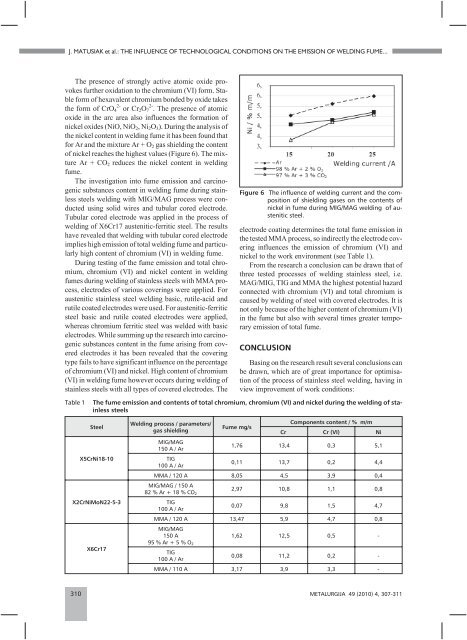PDF - 3756 kB - CARNet
PDF - 3756 kB - CARNet
PDF - 3756 kB - CARNet
You also want an ePaper? Increase the reach of your titles
YUMPU automatically turns print PDFs into web optimized ePapers that Google loves.
J. MATUSIAK et al.: THE INFLUENCE OF TECHNOLOGICAL CONDITIONS ON THE EMISSION OF WELDING FUME...<br />
The presence of strongly active atomic oxide provokes<br />
further oxidation to the chromium (VI) form. Stable<br />
form of hexavalent chromium bonded by oxide takes<br />
the form of CrO4 2- or Cr2O7 2- . The presence of atomic<br />
oxide in the arc area also influences the formation of<br />
nickel oxides (NiO, NiO2,Ni2O3). During the analysis of<br />
the nickel content in welding fume it has been found that<br />
for Ar and the mixture Ar + O2 gas shielding the content<br />
of nickel reaches the highest values (Figure 6). The mixture<br />
Ar + CO2 reduces the nickel content in welding<br />
fume.<br />
The investigation into fume emission and carcinogenic<br />
substances content in welding fume during stainless<br />
steels welding with MIG/MAG process were conducted<br />
using solid wires and tubular cored electrode.<br />
Tubular cored electrode was applied in the process of<br />
welding of X6Cr17 austenitic-ferritic steel. The results<br />
have revealed that welding with tubular cored electrode<br />
implies high emission of total welding fume and particularly<br />
high content of chromium (VI) in welding fume.<br />
During testing of the fume emission and total chromium,<br />
chromium (VI) and nickel content in welding<br />
fumes during welding of stainless steels with MMA process,<br />
electrodes of various coverings were applied. For<br />
austenitic stainless steel welding basic, rutile-acid and<br />
rutile coated electrodes were used. For austenitic-ferritic<br />
steel basic and rutile coated electrodes were applied,<br />
whereas chromium ferritic steel was welded with basic<br />
electrodes. While summing up the research into carcinogenic<br />
substances content in the fume arising from covered<br />
electrodes it has been revealed that the covering<br />
type fails to have significant influence on the percentage<br />
of chromium (VI) and nickel. High content of chromium<br />
(VI) in welding fume however occurs during welding of<br />
stainless steels with all types of covered electrodes. The<br />
Figure 6 The influence of welding current and the composition<br />
of shielding gases on the contents of<br />
nickel in fume during MIG/MAG welding of austenitic<br />
steel.<br />
electrode coating determines the total fume emission in<br />
the tested MMA process, so indirectly the electrode covering<br />
influences the emission of chromium (VI) and<br />
nickel to the work environment (see Table 1).<br />
From the research a conclusion can be drawn that of<br />
three tested processes of welding stainless steel, i.e.<br />
MAG/MIG, TIG and MMA the highest potential hazard<br />
connected with chromium (VI) and total chromium is<br />
caused by welding of steel with covered electrodes. It is<br />
not only because of the higher content of chromium (VI)<br />
in the fume but also with several times greater temporary<br />
emission of total fume.<br />
CONCLUSION<br />
Basing on the research result several conclusions can<br />
be drawn, which are of great importance for optimisation<br />
of the process of stainless steel welding, having in<br />
view improvement of work conditions:<br />
Table 1 The fume emission and contents of total chromium, chromium (VI) and nickel during the welding of stainless<br />
steels<br />
Steel<br />
X5CrNi18-10<br />
X2CrNiMoN22-5-3<br />
X6Cr17<br />
Welding process / parameters/<br />
gas shielding<br />
Fume mg/s<br />
Components content / % m/m<br />
Cr Cr (VI) Ni<br />
MIG/MAG<br />
150A/Ar<br />
1,76 13,4 0,3 5,1<br />
TIG<br />
100A/Ar<br />
0,11 13,7 0,2 4,4<br />
MMA / 120 A 8,05 4,5 3,9 0,4<br />
MIG/MAG / 150 A<br />
82%Ar+18%CO2<br />
2,97 10,8 1,1 0,8<br />
TIG<br />
100A/Ar<br />
0,07 9,8 1,5 4,7<br />
MMA / 120 A 13,47 5,9 4,7 0,8<br />
MIG/MAG<br />
150 A<br />
95%Ar+5%O2<br />
1,62 12,5 0,5 -<br />
TIG<br />
100A/Ar<br />
0,08 11,2 0,2 -<br />
MMA / 110 A 3,17 3,9 3,3 -<br />
310 METALURGIJA 49 (2010) 4, 307-311
















